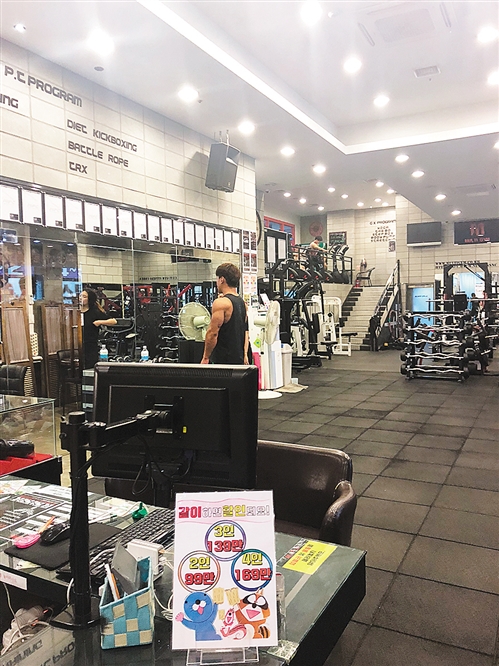
Interior of a gym in Seoul. Photo by Bai Yunfei
There is a lot of knowledge in the gym. Besides exercising and shaping the body, the facilities and fitness crowd in the gym also reflect the people’s living and economic development level in a region.
Not long ago, the author went to South Korea for an interview. In my spare time, I went to several gyms in South Korea to sweat and feel the fitness atmosphere and culture in South Korea.
In the morning, the author came to the fitness club located at the top of the hotel. I thought there should be no one at 7 o’clock. I didn’t expect that when I entered the door, a dozen treadmills lined up in a row were all idle, and people were struggling to run in uniform pink T-shirts and white shorts. Looking at the audience wearing different sportswear, I was a little embarrassed. I recalled that the waiter had just talked in Korean. It seems that I should ask: "Do you need to change clothes?"
After several times of fitness, the author found that one of the characteristics of Korean gymnasiums is that during the period from 7: 00 to 9: 00, the people who exercise are mainly middle-aged, and many of their hair has turned white. In the equipment area, several middle-aged uncles are working hard to lift iron. A fat uncle of about 50 years old invited a private tutor. The private tutor is very strong, quiet, polite and older, which is in great contrast with the domestic private tutor who is generally a young man in his twenties.
Moreover, the gym has a large area and a humanized design. In addition to the relatively complete exercise equipment, there are also special clothes, towels, drinking water, food to replenish energy, and special equipment to stretch and relax muscles after exercise. There is also a medical emergency room at the door. The sports equipment in the gym is well maintained, and there are traces of manual repair and reinforcement in many parts. It can be seen that the manager of the gym is running the store with heart.
In fact, the Korean fitness industry started relatively early, and the atmosphere is relatively strong. According to survey data, the penetration rate of fitness population in South Korea is 7.3%, and fitness has become a habit for Koreans. A few years ago, South Korea’s bodybuilding industry sprang up suddenly, and many athletes won some top international competitions, which made fresh Asian faces appear in the bodybuilding industry that has always been dominated by Europeans and Americans.
Whether it is fitness or bodybuilding, the place is very important. To a certain extent, gyms can objectively reflect the people’s living and economic development level of a region. Why? Because people generally eat well, dress well and live well, and their living conditions have improved, people have the mind to pursue a healthier and higher standard lifestyle.
On the one hand, consumers should be able to afford fitness expenses beyond their daily living expenses, such as gym membership cards, fitness clothes, equipment, and even customized private courses. It is understood that the cost of finding a private tutor in Seoul is about 50,000 to 100,000 won an hour, which is about RMB from 330 yuan to 660 yuan.
On the other hand, consumers should have a scientific and systematic understanding of fitness, understand the importance of fitness shaping, and have enough leisure time to engage in this sport. For example, a good and strong body shape requires a high-quality diet. A professional bodybuilder eats about 20 to 40 egg whites and a lot of chicken breast, beef, protein powder and vegetables every day, which is not a small expense. If you can’t even fill your stomach, you can’t talk about fitness.
Judging from the situation in South Korea, the 1960s and 1990s witnessed rapid economic growth in South Korea for 30 years. During this period, South Korea developed from a traditional and closed agricultural country to a newly industrialized country under the export-oriented strategy. Per capita GDP also rose from less than $100 in the 1960s to more than $30,000 in 2018. Economic and social development has laid a solid foundation for the Korean fitness industry.
Especially in recent years, South Korea’s fitness industry has entered a relatively stable growth stage. According to the report "The Status of Merchants in 100 Industries" released by the National Tax Agency of Korea, as of September 2018, the number of professional fitness venues such as yoga training grounds and tennis courts in Korea has increased significantly, from 2,132 in September 2014 to 6,465, an increase of 203.2%. Among them, the gym increased by 51.5%.
There are many middle-aged people in Korean gyms, so where are the young people in Korea? Since 2017, South Korea’s economic growth rate has continued to decline, and the Bank of Korea and international institutions have recently lowered their economic growth expectations for 2019. At the same time, income polarization, low birth rate, aging and many other problems have also cast a shadow over the economic prospects of South Korea.
A colleague who has worked in Korea for many years said that young people in Korea are under great pressure to live and work, and they are busy running around and socializing every morning and evening, and their employment situation is not very optimistic. At the same time, their start-up costs are high and risks are great. Due to the pressure of life and work, many young people have no time or energy to spend in the gym. It seems that there are many conditions for sweating in the gym.
(This article is written by Chang Li)
